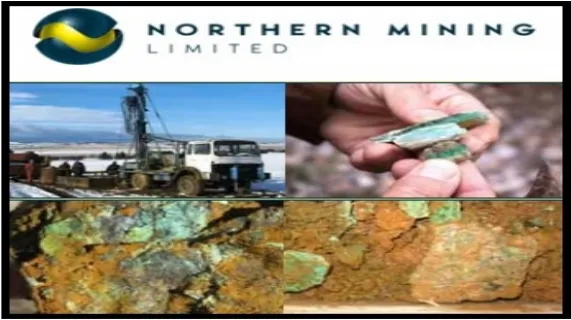
Increased Resource Potential within Extensive Gold System
Perth, May 2, 2013 AEST (ABN Newswire) - Ravensgate Mining Industry Consultants (Ravensgate) were recently contracted by Northern Mining Limited ( ASX:NMI) to carry out an independent review of the Blair North, Kanowna Lights and Snake Hill Prospects in the East Kalgoorlie Project.
ASX:NMI) to carry out an independent review of the Blair North, Kanowna Lights and Snake Hill Prospects in the East Kalgoorlie Project.
Ravensgate considers the East Kalgoorlie Project area highly prospective for structurally controlled orogenic lode gold deposits, of which there are many examples in the surrounding greenstone belt.
EAST KALGOORLIE PROJECT, WESTERN AUSTRALIA
The East Kalgoorlie Project = 33 licences comprising 21 licences JV NMI 79%, Balagundi Gold 21%,12 licences NMI 100%
The East Kalgoorllie Project is positioned in a prime location in terms of a regional geological and gold mineralisation setting. It lies in a well-endowed gold region, the Eastern Goldfields granite-greenstone belt, close to major crustal structures, underlain by Archaean greenstone lithologies with late stage felsic intrusions. There is significant gold mineralisation in the immediate district including the Kanowna Belle, Kalgoorlie, Mt Charlotte and Golden Ridge mines plus numerous smaller mines, workings, unmined deposits and occurrences including the George's Reward/Cannon Prospects + 100,000 ounce deposit.
BLAIR NORTHPROSPECT, NORTHERN ZONE
Ravensgate Recommendations:
In Ravensgate's opinion, significant, further exploration of the Blair North area is warranted.
Northern Zone Highest priority:
- Northern Zone holes targeting margins of granitic bodies; and- opportunities for exploration success exist to the south and east of gold bearing lodes defined by existing drilling.
Northern Zone Drilling Targets - North-South to NNE Trending Corridor:
Ravensgate considers that opportunities for exploration success exist to the south and to the east of gold bearing lodes defined by existing drilling (Figure 1). Holes targeting margins of granitic bodies are the highest priority for further exploration of the Northern Zone.
The indications from results of structural logging are that an approximately N-S to NNE trending (moderately-steeply W-WNW dipping) discrete shear corridor may localise the vein-fracture hosted Au mineralisation in the Northern Zone. It is recommended this N-S to NNE-trending corridor be targeted with drilling.
In addition, an attractive target may exist where this shear corridor exits the southern and northern ends of the tonalite-trondhjemite body. NE and NW trending cross shears also appear to have been active during Au-related alteration and may well play an important role in localising mineralisation within the N-S corridor.
Intersections close to the surface were modelled as flat lying plates which fitted the data well and is geometrically typical of supergene gold intersections in deep regolith elsewhere in the Yilgarn. Deeper intersections were modelled as thin planar lodes shallowly dipping to the west. Where lodes could not be connected to any further drill holes, they were projected to approximately half the drill hole spacing of the nearest hole.
The result of this work was a stacked series of relatively shallowly west dipping lodes dominantly hosted by granitic rocks with their gross geometry probably reflecting the shape of the granitic stock. This illustrates that a large volume of rock mass has been mineralised.
BLAIR NORTH PROSPECT, SOUTHERN ZONE
Lithologies intersected by recent drilling, indicate that the host stratigraphy continues north from George's Reward and therefore favourable structures in the Southern Zone prospect area offer viable exploration targets.
Ravensgate concludes that there remains opportunity to develop conceptual Au targets in the Southern Zone to the north of George's Reward and further geological, geophysical and/or geochemical work to develop sufficiently robust drill targets is recommended.
BLAIR NORTH PROSPECT, GEORGE'S REWARD
Ravensgate concurs with the previously reported estimation of the exploration potential of 25,000 to 30,000 tonnes at a grade range of 1.4 to 1.9 g/t Au additional to the Inferred Resource announced in February 2010. Ravensgate concluded that George's Reward has been sufficiently tested.
George's Reward forms a contiguous mineral deposit with the Cannon deposit in Southern Gold Limited's (SAU) tenements immediately south of the Blair North Project.
George's Reward comprises approximately 20% of the overall gold content of the combined deposits. Data released by SAU indicate that some of the best intersections within Cannon are located very close to the tenement boundary.
EAST KALGOORLIE PROJECT - KANOWNA LIGHTS PROSPECT
Ravensgate Recommendations:
In Ravensgate's opinion, there is realistic potential that the aeromagnetic anomaly is related to magnetite alteration associated with a gold mineralised system.
Ravensgate rates the aeromagnetic anomaly as a high priority target which should be tested with a program of diamond drilling. Results achieved from the initial hole will determine the strategy and design of subsequent drilling. This target will not be fully tested by a single drill hole, however, the hole proposed is well positioned to yield positive results should the geological theory behind the proposal be fulfilled.
Significant, further exploration of the Kanowna Lights Prospect area is warranted.
Kanowna Lights Highest priority:
- Drill targets within geophysical aeromagnetic anomaly - depth to target estimated at 245 metres
Kanowna Lights Priority One Drilling Targets:
There is realistic potential that the aeromagnetic anomaly shown in Figure 4 is related to magnetite alteration associated with a gold mineralised system. Historical drilling across this feature was all vertical and spaced 80m apart. Field reconnaissance of this historical drilling to identify the source of this magnetic anomalism noted that all drill holes across the magnetic feature had terminated in basal palaeochannel gravels and had failed to intersect bedrock lithologies.
Geophysical interpretation utilising magnetic inversion modelling techniques has been undertaken by Newexco Services (Newexco) providing a depth to target estimate of 245m, and a 3D model showing magnetic response relative to proposed drilling was developed.
Southern Bedrock Geochemical Anomalies
Two targets have also been identified around section 6,617,080N directly under and immediately west of significant oxide zone gold anomalies. Neither of these zones have been tested by drilling and Ravensgate endorses these as priority 2 targets.
EAST KALGOORLIE PROJECT - SNAKE HILL PROSPECT
Ravensgate Recommendations:
Ravensgate considers the Snake Hill Prospect to be worthy of further exploration for structurally controlled orogenic lode gold deposits, utilising geological models established by recent work undertaken by NMI.
Consideration could be given to undertaking an induced polarisation geophysical survey over the defined geochemical anomaly, given the success of this technique at the Blair North project.
Geophysical interpretation should be undertaken of the data from a gravity survey carried out by Haines Surveys. The survey was conducted over the main area of drilling and undertaken on lines 40 metres apart, with station intervals at 10 metres.
Snake Hill Highest priority:
- Further interpretation of extensive geochemical anomaly
Snake Hill Priority One Drilling Targets:
Prior to further drilling, Ravensgate recommends that interpretation of existing geophysical and geochemical data sets be completed, including the recently acquired gravity data, airborne magnetics and multi-element analysis of RAB and RC samples. Also, petrographic analysis of core from SHD003.
An extensive geochemical anomaly has been defined with an area of 3 kilometres along strike and 1.5 kilometres along dip assaying greater than +20 ppb Au, with a peak value of 491 ppb Au. This anomaly straddles the Mt Monger Fault and appears to be associated with 3 subsidiary parallel structures mapped by drilling.
Prior to further drilling, Ravensgate recommends that interpretation of existing geophysical and geochemical data sets be completed, including the recently acquired gravity data, airborne magnetics and multi-element analysis of RAB and RC samples. Also, petrographic analysis of core from SHD003. Consideration could be given to undertaking an induced polarisation geophysical survey over the defined geochemical anomaly, given the success of this technique at the Blair North project.
Further deep drilling should be undertaken along three or four widely spaced sections across the Mt Monger Fault geochemical anomaly, with detailed targeting based on the results of the work recommended above and existing drill sample analytical results.
NMI MOVING FORWARD:
Capital Raising
The Company is currently active in seeking to raise funds to commence drilling on the Blair North, Northern Zone and Kanowna Lights highly prospective drill targets.
Funds raised will be utilised to commence co-funding for exploration drilling under the WA Government, Royalties for Region, Exploration Incentive Scheme for two diamond drill holes at the Northern Zone and one diamond drill hole at Kanowna Lights. These drilling programs will be the commencement of further drilling programs to increase the resource potential at the Northern Zone and to test the aeromagnetic anomaly to ascertain if it is related to magnetite alteration associated with a gold mineralised system.
To view all diagrams and figures, please visit:
http://media.abnnewswire.net/media/en/docs/ASX-NMI-634384.pdf
Contact
Northern Mining Limited
T: (08) 9244 8499
F: (08) 9244 3166
WWW: www.northernmining.com.au/
| ||
|





